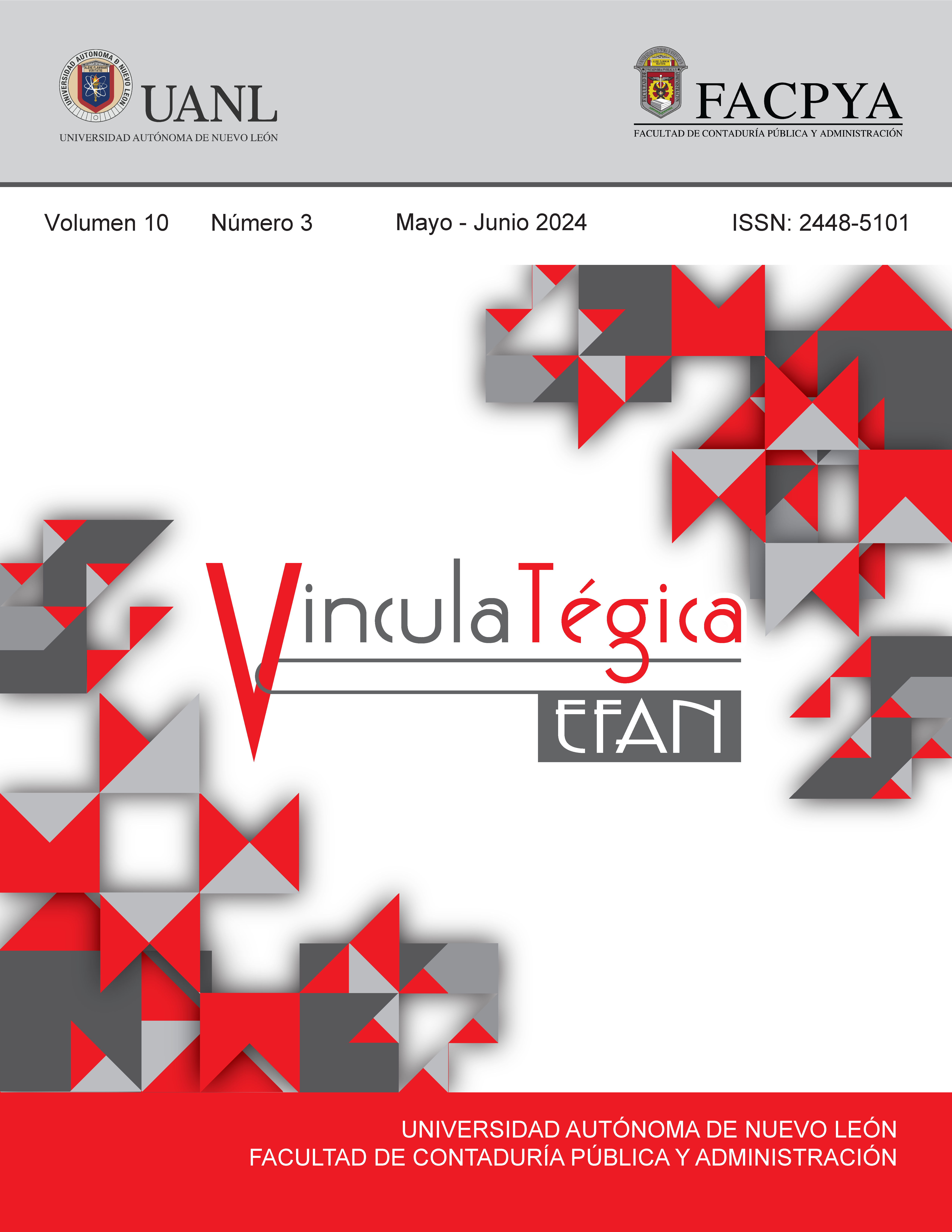Determinants of Tax Evasion in Mexico: Case applied to FACPYA Graduate Students of the UANL
DOI:
https://doi.org/10.29105/vtga10.3-509Keywords:
Evasion, EFOS, EDOS, Morals and Culture, EthicsAbstract
The objective of this research is to evaluate the perception of graduate students about companies that invoice and deduct simulated operations, considering morality, culture, tax trust and ethics as determinants of tax evasion in Mexico. The study was carried out at the beginning of the semester January - June 2022, in week 15, from May 09 to 14, the survey was applied to students of different master's degrees offered by the FACPYA Postgraduate. It was carried out using a quantitative and qualitative approach, that is, mixed, considering a sample of 50 students. For the collection of information, a survey-type instrument designed with Likert model items was considered. For data analysis, the confirmatory factor analysis technique was used. The results obtained from the KMO were .718, the Bartlett sphericity test an approximate Chi-square of 903.782, degrees of freedom of 276 with a significance of .000. Through data analysis, they show significant factors in tax evasion as a result, one of them being simulated operations with a total explained variance of 37,613%. Therefore, it is concluded that the alternative hypothesis is not rejected H1: For postgraduate students, efos, edos, morality, culture, tax trust and ethics are significant determinants of tax evasion in companies in Mexico.
Downloads
References
Allingham, M. G. y A. Sandmo (1972). “Income tax evasion: A theoretical analysis”. Journal of Public Economics, vol 1, pp 323-338. DOI: https://doi.org/10.1016/0047-2727(72)90010-2
Bernal et al. (2003). Modelización de los factores más importantes que caracterizan un sitio en la red. XXI Jornadas de ASEPUMA.
Crowe, Martin T. (1944). The Moral Obligation of Paying Just Taxes, The Catholic University of America Studies in Sacred Theology No. 84.
Cremer, H. y F. Gahvari (1993). “Tax Evasion and Optimal Commodity Taxation”. Journal of Public Economics, vol 50, pp 261-275. DOI: https://doi.org/10.1016/0047-2727(93)90052-U
Cronbach LJ. (1951) Coefficient alpha and the internal structure of test. Psychometrika. 1951;16:297-334. DOI: https://doi.org/10.1007/BF02310555
Field, A. (2009) Discovering Statistics Using SPSS. 3rd Edition, Sage Publications Ltd., London. P.675
Hair, J.F., Anderson, R.E., Tatham, R.L. & Black, W.C. (1999). Análisis de Regresión (Trad. Multivariate Data Analysis). En: Prentice Hall International (5ª ed.), Análisis Multivariante (pp. 143-235). Madrid: Prentice Hall Iberia.
Hair, J.F.J. , Hult, G.T.M. , Ringle, C.M. and Sarstedt, M. (2017), A Primer on Partial Least Squares Structural Equation Modeling (PLS-SEM) , 2nd ed., Sage, Thousand Oaks, CA, available at: www.amazon.de/Partial-Squares-Structural-Equation-Modeling/dp/148337744X/ref=sr_1_1?ie=UTF8 & qid=1462617386 & sr=8-1 & keywords=PLS-sem#reader_148337744X.
Káiser, H.F. “The Varimax criterion for analytic rotation in factor analysis”. Psychometrika, 1958. DOI: https://doi.org/10.1007/BF02289233
Likert, R. (1932). A technique for the measurement of attitudes. Archives of Psychology, 22 140, 55.
Nunally, J. (1987) Teoría Psicométrica. México: Trillas
OCDE et al. (2021). Organización para la cooperación y el desarrollo económico. Recuperado el 3 de octubre de 2021 de: https://www.oecd.org/acerca/
Oviedo, H. C., & Campo-Arias, A. (2005). Aproximación al uso del coeficiente alfa de Cronbach. Revista colombiana de psiquiatría, 34(4), 572-580. DOI: https://doi.org/10.7705/biomedica.v26i4.327
Rositas, J. (2014). Los tamaños de las muestras en encuestas de las ciencias sociales y su repercusión en la generación del conocimiento (Sample sizes for social science surveys and impact on knowledge generation). Innovaciones de negocios, 11(22), 235-268.
Schmölders, G. (1970a). Finanzpolitik, 3rd edn. Berlin, Heidelberg, New York: Springer.
Servicio de Administración tributaria. Recuperado el día 28 de mayo de 2021 http://omawww.sat.gob.mx/cifras_sat/Paginas/datos/vinculo.html?page=ListCompleta69B.html
Song, Y. & Yarbrough, T. (1978). “Tax ethics and taxpayer attitudes: A survey”. Public Administration Review, (pp. 442–452). DOI: https://doi.org/10.2307/975503
Spicer, M. & Lundstedt, S. (1976). “Understanding tax evasion”. Public Finance= Finances publiques, 31(2), 295–305.
Vogel, J (1974). Taxation and Public Opinion in Sweden: an Interpretation of Recent Survey Data. Natl. Tax J. 27: 499-513. DOI: https://doi.org/10.1086/NTJ41861983
Downloads
Published
How to Cite
Issue
Section
License
Copyright (c) 2023 Noe Francisco Rico Martínez, Alfonso Hernández Campos

This work is licensed under a Creative Commons Attribution 4.0 International License.
a). Authors keep copyright and give the journal the right of the first publication of the work under a Creative Commons attribution license. This license allows others to share the work as long as original authorship and initial publication in this journal is acknowledged.
b). Authors may make other independent and additional contractual agreements for the non-exclusive distribution of the version of the article published in this journal (e.g., include it in an institutional repository or publish it in a book) as long as they clearly indicate that the work was published for the first time in this journal.







